When you’re short on space, that doesn’t mean that you can’t add a little Nature to your home. There are all kinds of small, but wonderful little plants that can really spice up the rooms of your choice – you just need to know what to look for!
Today we’ve compiled a nice little list of 17 tiny houseplants that should fit the bill quite nicely. Each of these has been selected carefully, with an eye for space, color, and ease of care, so take a look and see what you think.
These plants might be little, but they have very, very big personalities!
1. Air Plants – Tillansia (650+ species)
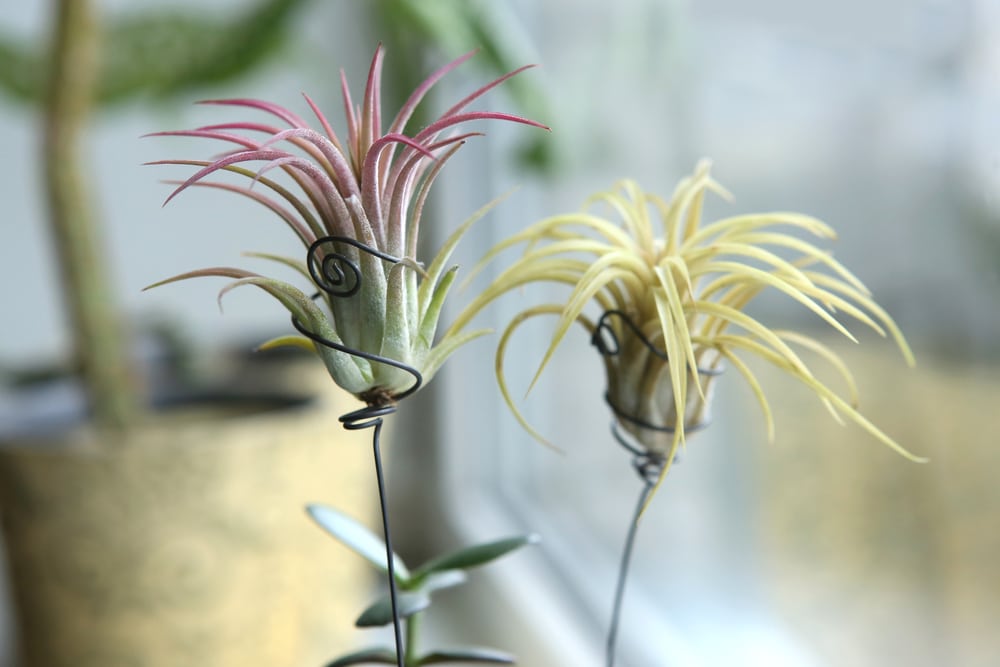
Air plants are some of the most compact plants out there and with 650+ species, you’ve got all kinds of interesting shapes and colors to choose from. Blue, purple, red, orange, and peach… that’s just a taste of the colors you can find, but what’s most fun about these plants is that you can grow them just about anywhere. Stick them in the bathroom, grow them on a kitchen magnet… you name it. Look for these and you can see for yourself. When it comes to space-saving plants, it’s hard to beat Air plants!
As far as soil requirements, these plants don’t actually need any – they can absorb what they need through their leaves. You can use an orchid potting mix if you like, though, as it’s super-aerated and works a treat. Your Air plants will need sunlight, however, and 4 to 6 hours of bright, indirect light is best. As far as watering, soak your tiny air plant in a bowl of water for 20 minutes every week and you’ll have a happy, healthy, and colorful air plant!
2. Echeveria – Echeveria (approx. 150 species)

Echeveria refers to a genus of plants where you may find over 150 species (and around 1000 cultivars) of small, beautiful plants that will look great in your home. These plants are native to South and Central American, as well as Mexico, and as they are succulents, they are a cinch to maintain! Echeveria rarely grow over a foot in height or width and the lovely florettes come in blue-gray, purple-gray, gray-green, and more.
For your Echeveria’s soil, cactus potting mix is easy to get and it’s a perfect fit for this plant. 6 hours of full, direct sunlight is required to keep your Echeveria happy and watering should be done once every 7 to 10 days or when the soil is mostly dry.
3. Mini Pilea – Pilea peperomioides
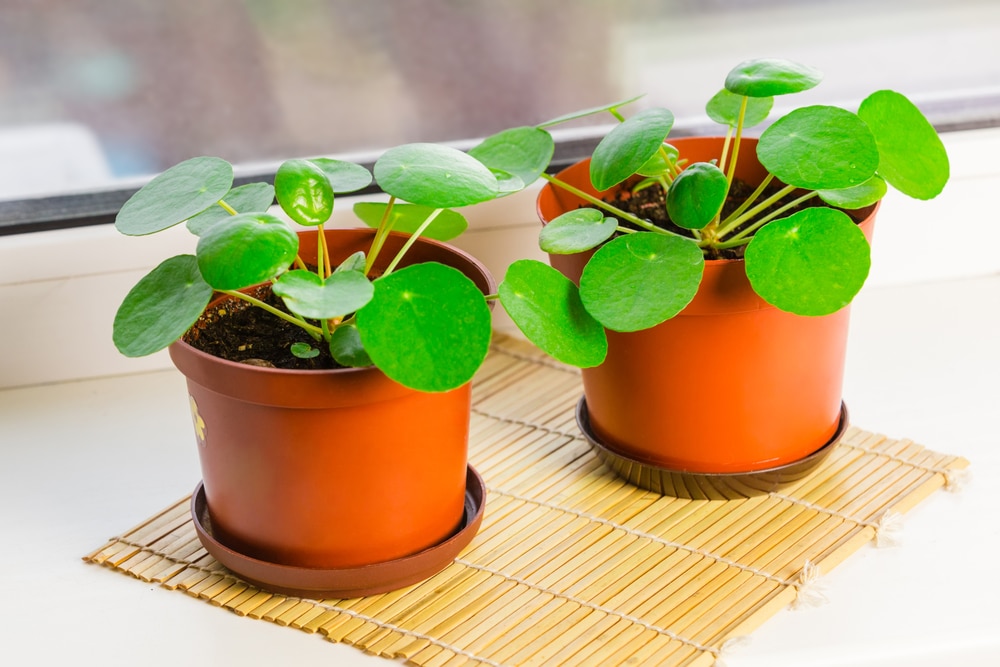
Also known as the ‘Chinese Money plant’, the mini Pilea is lovely, vibrant green leaves that are waxy and rounded and which are supported on slender, graceful stems. These plants stay fairly small, topping out at a height of about 12 inches, and you’ll occasionally notice little ‘pups’ sprouting from the soil next to their parent. These can be transplanted to grow more money plants in your home or to make a nice give for a friend who could use a little green in their home!
For mini Pilea plants, a peat moss-based soil with a handful of perlite in the mix is a great fit for this plant. Give it lots of bright, indirect sunlight and water it every 7 to 10 days or when the top 2 inches of soil are dry.
4. Aloe Pepe – Aloe Descoingsii x Haworthioides
A small, dark or lime-green Aloe plant hybrid that grows in cooler environments? That’s right! The Aloe Pepe is a cute little Aloe plant that’s growing in popularity across the world. A mix of the smallest Aloe plant and the Haworthia, these little guys grow slowly to a maximum height of 12 inches, with a diameter of about 2 inches. They’re also quite forgiving if you miss the occasional watering, so they are super easy to maintain. With a little luck, you might even get one or two flowers, which can grow up to a foot in overall length but still won’t take up too much space.
For proper soil, use commercial cactus mix at a 50/50 ratio with coarse sand or perlite for improved drainage. Full or partial sunlight is best for a happy Pepe and you should water it every 10 – 12 days (or when the soil is completely dry). These little guys can store water for about a week, so you’ve got some time to learn the perfect schedule, just be careful not to overwater them and remember that in winter, you’ll barely need to water them at all.
5. Baby Toes – Fenestraria aurantiaca
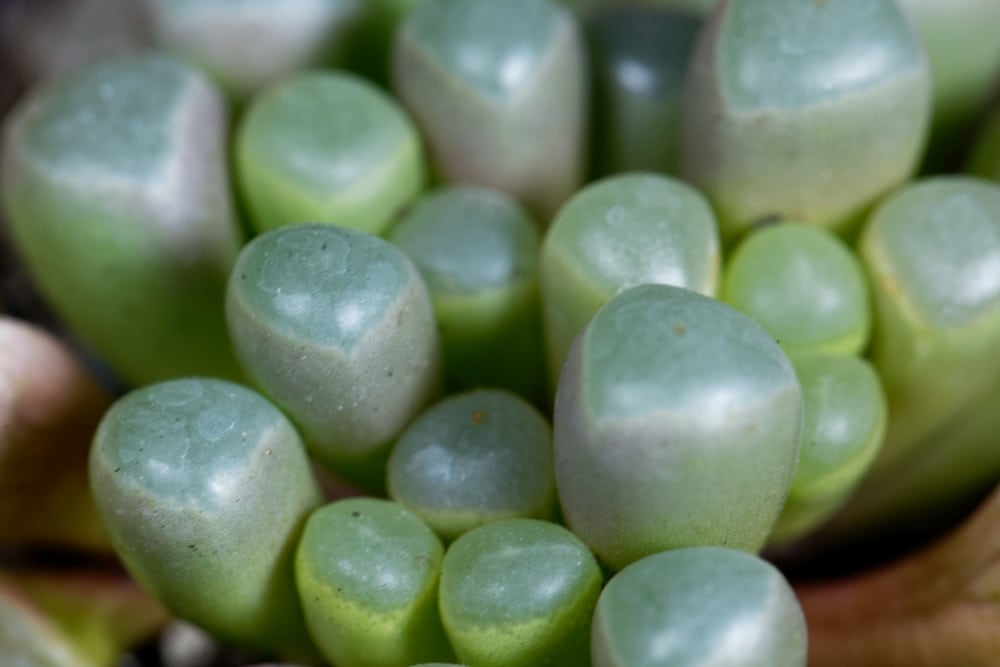
If you like alien-looking plants, then today is your lucky day! The ‘Baby Toes’ plant is both beautiful and strange, with light-green, fingerlike digits that grow 3 – 6 inches from their soil and which have a diameter of just 1 ¼ inch along with 1 ½ inch leaves. These little succulents are easy to take care of and a pleasure to look at, so be sure that you pick a place where they can be easily seen – this is one plant that you’ll definitely get a lot of questions and comments about!
A 50/50 mix of regular potting soil with perlite or pumice is an ideal base for your Baby Toes to grow. Just be sure to put them near a window where they can get a lot of sun – these plants like about 6 to 8 hours a day of direct sunlight, if possible. Also, Baby Toes are extremely sensitive to overwatering, so only water them when their soil is completely dried out. This will likely be every 10 to 12 days, but environments vary, so you’ll need to check on your own until you’ve learned your plants ideal schedule.
6. Madagascar Widow’s thrill- Kalanchoe blossfeldiana
How’s THAT for a name, eh? The Madagascar Widow’s thrill is a popular name that actually encompasses 125 species of different plants, native to Madagascar and Africa. They have pretty, dark green leaves and flowers of red, orange, pink, bicolor, and more, but most varieties are only going to grow to a maximum height of 8 to 12 inches. This makes them a perfect colorful plant for home that won’t need much space, but will definitely ‘fill’ the one that it occupies with a pot full of beauty.
Widow’s thrill does best in a 60/40 mix of peat moss and perlite. There is a trick to getting them to bloom, however, and it requires that you cover them for 14 hours a day and then let them have indirect sunlight until the blooms form. After that, you can move them anywhere that they can get bright and indirect sunlight. Watering frequency is fairly simple, just check the top 2 inches of soil and water your Kalanchoe whenever this is dry… typically once every 2 weeks.
7. Snake Plant – Dracaena trifasciata

Snake plants are a sharp-looking addition to any home, with their long, thin, and dark green leaves which have a lighter green banding across them and stand straight up in the pot. While they grow around 2 and 3 feet long in the wild, indoors they’ll generally top out at around 7 or 8 inches and this makes them ideal for adding some green to your home when space is at a premium.
One part regular potting soil, mixed in with 2 parts perlite, makes for a well-aerated bed of soil that’s ideal for your Snake plant. Succulent and cactus mix is also great, if you don’t feel like mixing your own soil. A few hours of bright, indirect sunlight every day is all that your Snake will need and you should water it when the soil is dry – typically one every 1 or 2 weeks.
8. Flaming Lily – Anthurium andraeanum
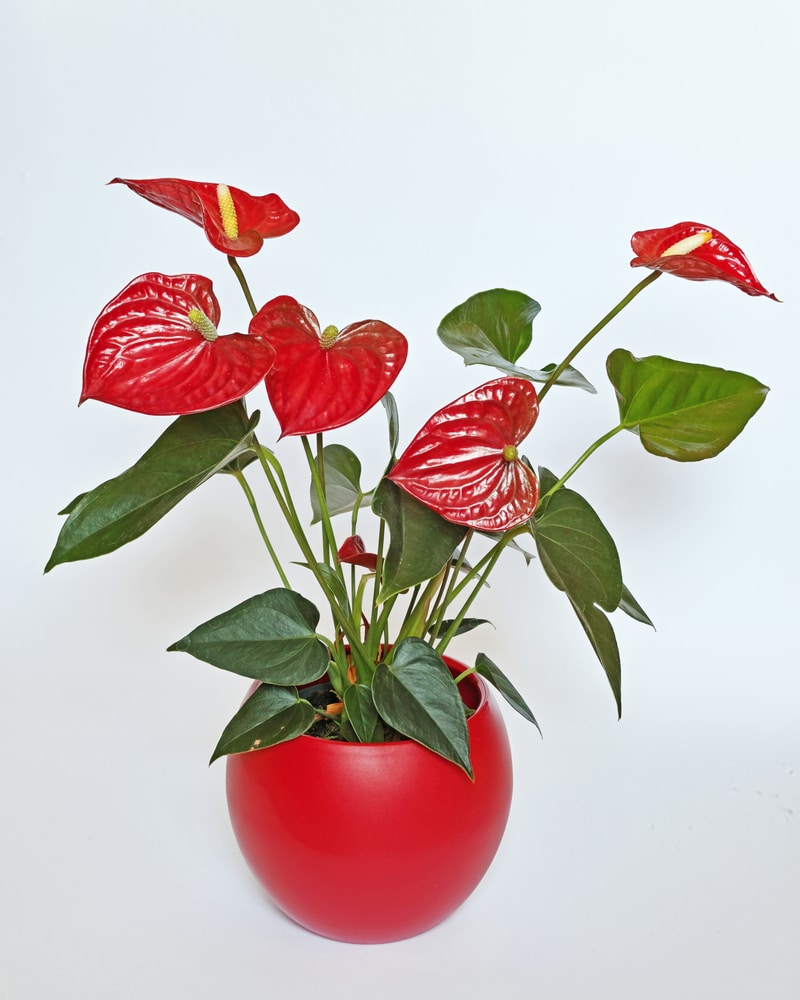
Also known as ‘Painter’s palette’, the lovely Flaming Lily is definitely a looker. Native to Columbia and to Ecuador, these slow-growing tropical plants can grow anywhere from 12 to 28 inches tall, making them one of the tallest plants on this list. There are lots of hybrids, so you can get a pretty good choice of color for the flowers, with examples including salmon, red, black-red, pink, and white to go with their waxy, dark green leaves. They’ll definitely add a good bit of color to your home.
Orchid mix with a little peat and coarse sand mixed in make a good base for these plants and bright, indirect sunlight will be best. These lovelies are very thirsty, so water them every 2 to 3 days or when the soil has completely dried out.
9. Mini African Violet – Saintpaulia ionantha
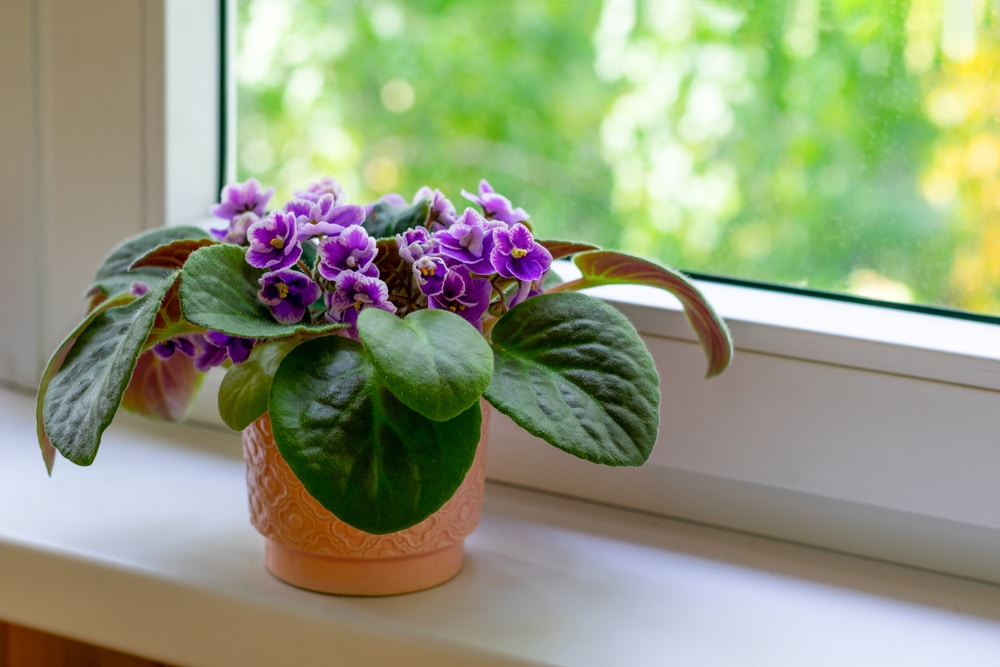
African violets do come in miniature varieties, which grow to be about 6 inches tall, with .75 inch violet flowers and light green, white-edged leaves approximately 1 inch in length. This gives you a great opportunity to color up your desk or brighten the kitchen a bit with a beautiful and low maintenance houseplant.
Cactus mix is an ideal soil for these beauties, so you can purchase this ready-made and avoid any worries about mixing it on your own. Give it lots of bright, indirect sunlight, and water it when the top inch of soil is dry – this might be twice a week or once every 2 weeks, so you’ll need to check until you can determine the needs for your plant and your specific environment.
10. Mini Watermelon Peperomia – Peperomia argyreia
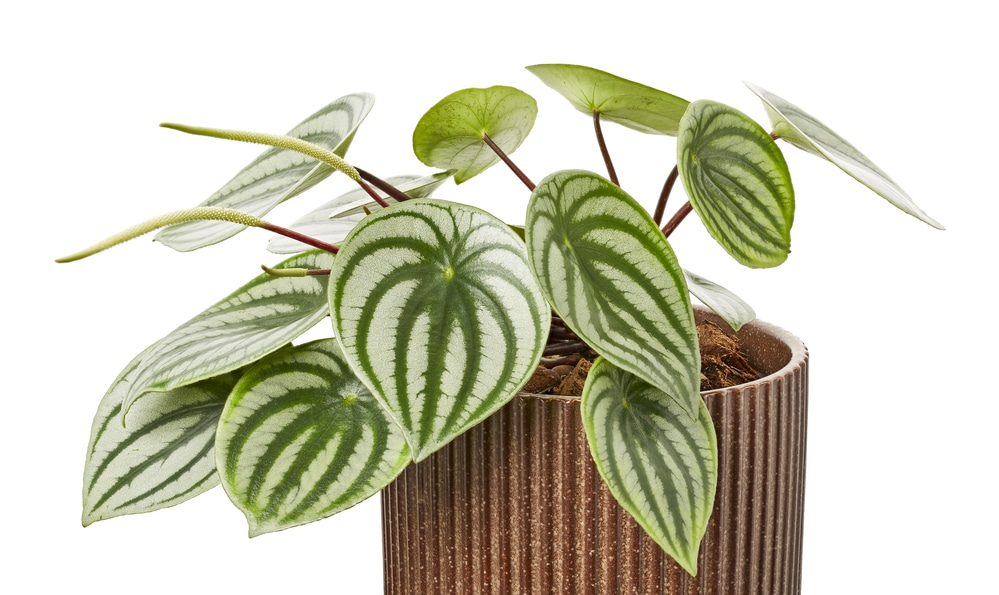
With a height of 6 inches, the Mini Watermelon Peperomia is about half the size of a standard Watermelon Peperomia but still packs a whole of character. The leaves of these plants do indeed mimic the skin of a watermelon, and you can find them in dark and light green varieties and even dark green and white ones on lovely red stems. These South American natives are also non-toxic to cats and dogs, which is always a plus with your houseplants!
Small pots are best for these plants and inside them, you’ll want to put an equal mix of peat moss and perlite for best results. Bright and indirect sunlight is best for your Mini-melon and water it once every 1 to 2 weeks when the soil has fully dried out. Don’t mist or water the leaves, by the way, as they are sensitive and this can cause them to rot!
11. Living Stone – Lithops (40+ species)
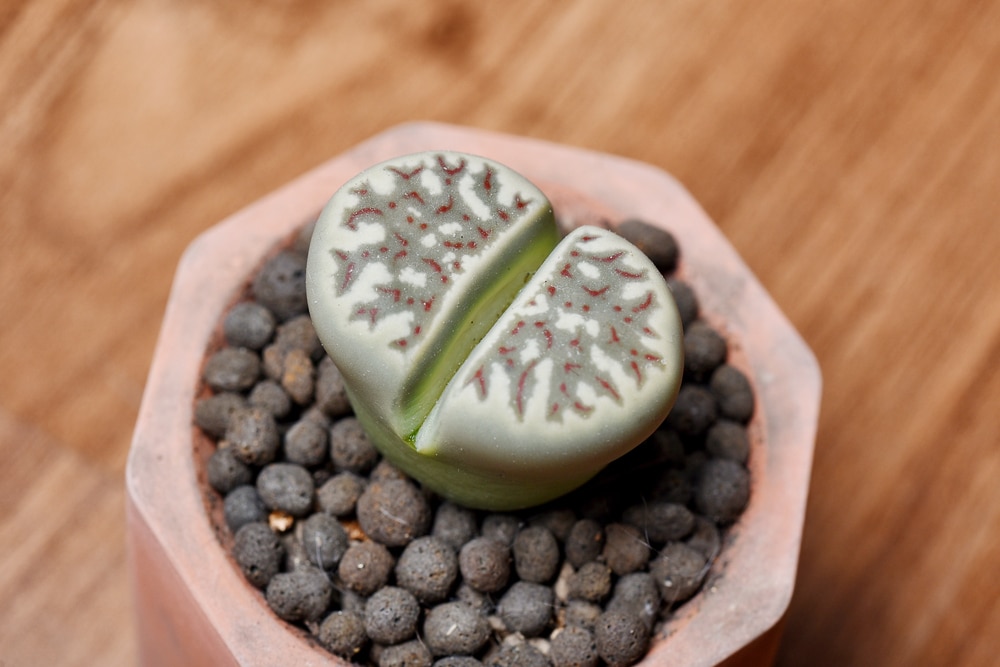
One of the most amazing compact houseplants that you can own are Lithops, known more commonly as ‘Living Stone’ plants. There are 40 species of these plants and over 145 varieties, so you’ve really got an amazing selection of looks and colors and they are definitely as-advertised – these plants look like colorful stones and if you put them in your home, you’ll be extremely happy that you did. The succulents grow about 1 inch high, and 3 inches wide, so they won’t even need much space!
Cactus potting mix with a little sharp sand or perlite is ideal for your Living stone and 5 or 6 hours of direct sunlight is ideal, so be sure to find a nice south-facing window to host your amazing new plants. Watering is a little trickier for these plants, as they can store it for weeks or even months.
The trick is to only water them in fall and spring and then only when the soil is completely dry – which usually every 2 weeks during these seasons only. Never water them during winter and only water in the summer if they are looking wrinkled, otherwise stick to spring and fall and these low-maintenance plants will thrive!
12. Venus Fly Trap – Dionaea muscipula
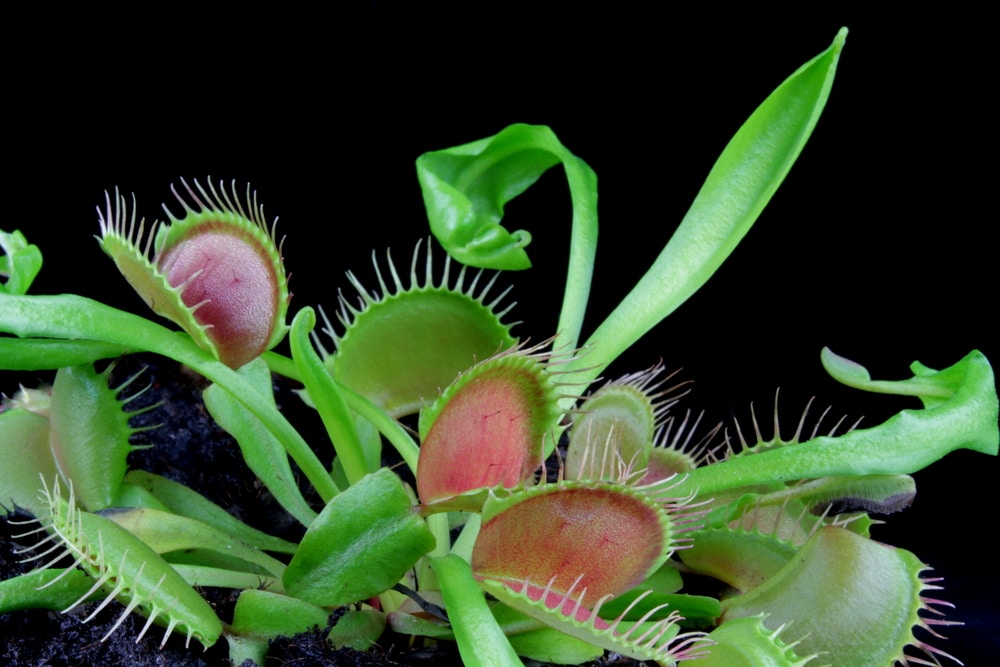
You know that you’ve wanted on of these since you were a kid and there’s no time like the present… why not get some Venus fly traps? Those light green and red, large-toothed wonders are recognized the world over. The caveat, of course, is a carnivorous plant, so you’re going to need to feed them either freeze dried bugs or when they get bigger, you can even go with small mealworms!
Indoors, these plants will only grow to be about 4 to 5 inches tall and this will take 2 to 4 years, so if you want a super-exotic, yet well-known plant that’s definitely on the fun and weird side, consider Venus fly traps.
For your flytrap’s soil, whip up a 50-50 mix of peat moss and perlite and stick with this… regular potting soil, cactus mix, and a lot of other mediums will kill them – so stick with moss and perlite. These plants like direct sunlight and need a lot of it during growing season, so this is definitely a south-window plant. Water them every 2 to 4 days, when the soil is feeling less moist, but don’t let the soil dry. Now, the fun part… Feed it every other week with a small amount of dehydrated, small insects (rehydrated, of course with a touch of water) or with small or chopped mealworms. You only have to feed one ‘trap’ to feed the whole plant, so don’t overdo it and you’ll soon have a happy, healthy little carnivore!
13. False Shamrock – Oxalis triangularis
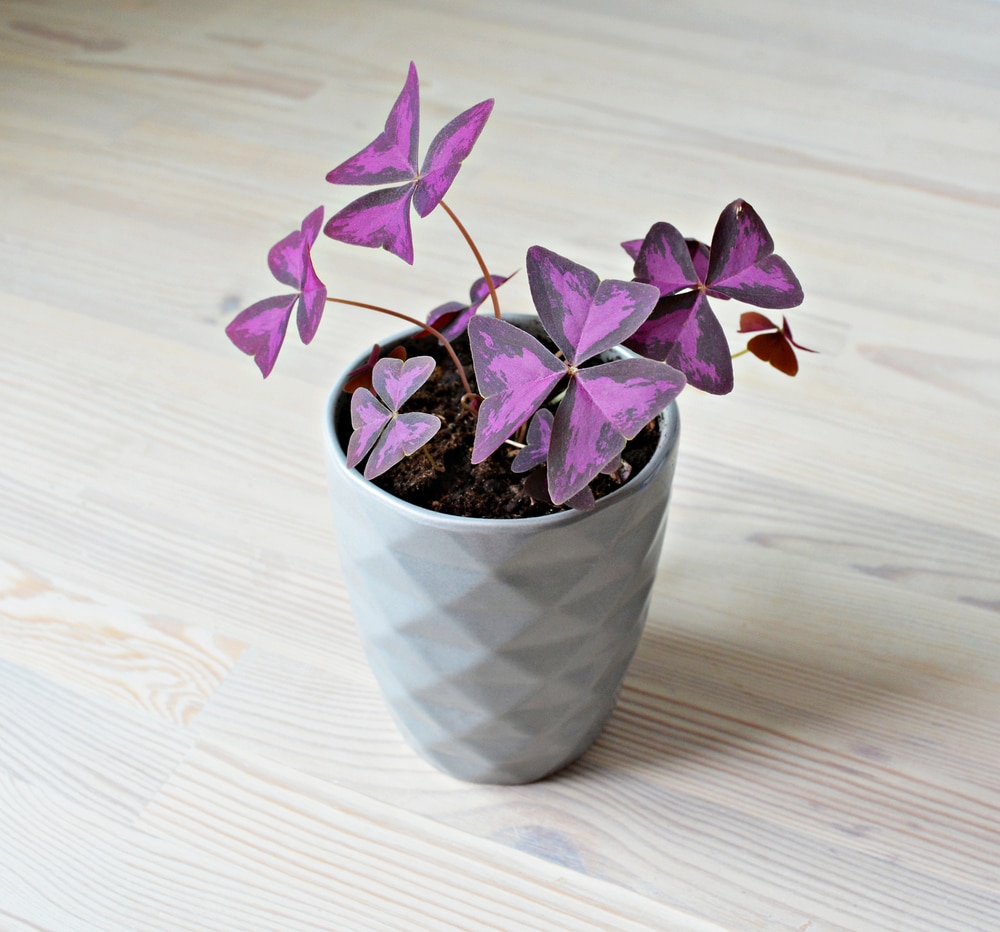
The Oxalis triangularis is another good looking plant that won’t need much space to really fill the room. It’s got triangular leaves that you can find in light and dark purples and even dark blues, so check around to find the one that you like best! Indoors, they can get up to 12 inches tall, and you can display them in a pot or a hangar, as you like.
A 50/50 mix of premium potting soil and perlite is just about perfect for your False Shamrock. Give it bright, indirect sunlight and you’ll water it once every 1 or 2 weeks – when the soil is half-dry.
14.Zebra Haworthia – Haworthiopsis attenuata
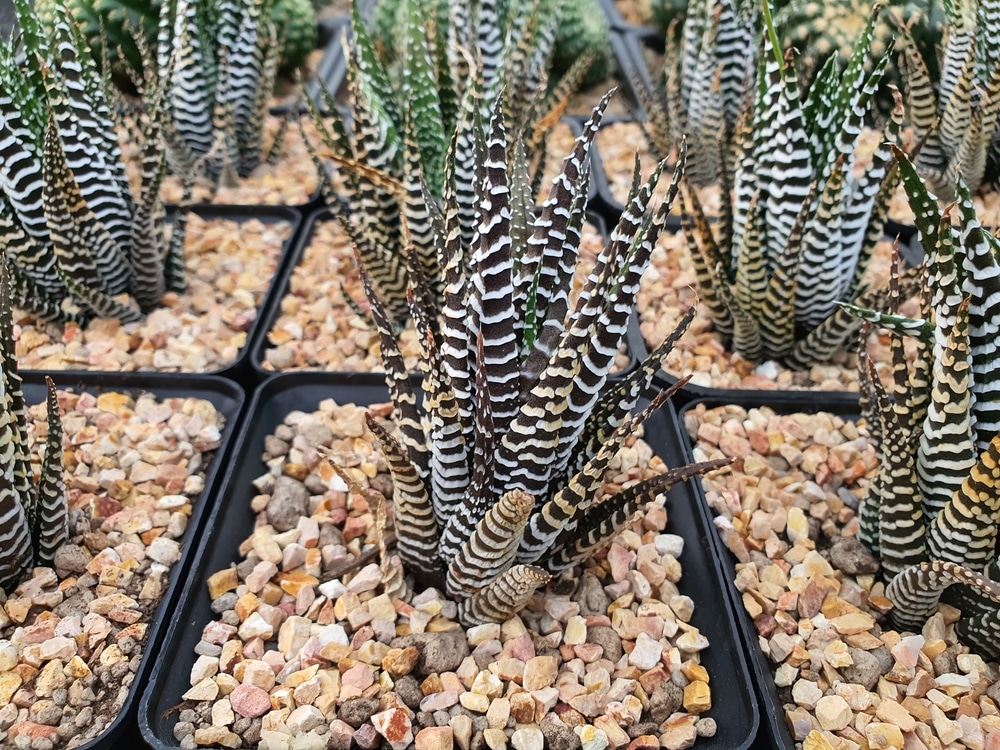
The Zebra Haworthia is a native of South Africa which has quite the distinctive look to it. Imagine the spiky, dark green or green-gray leaves of an aloe vera and throw in some white stripes and you’ll have a pretty good mental image of it. These plants are a great choice for decorating your home with an eye for saving space, topping out at 5 to 8 inches tall. Best of all, you won’t need to change pots anytime soon, as they grow slowly and the care required to keep them happy is very, very minimal.
Cactus potting soil is going to be the easiest way to make your chosen pot into a lovely new home for your plant. Bright and indirect sunlight is going to be ideal for these plants, though they can adapt to lower light if necessary – just expect a much slower growth cycle. Water your plant every 2 to 3 weeks, making sure that the soil is completely dried out before you so, and your plant will be happy and healthy indeed!
15. Hoya Heart Plant – Hoya kerrii

With it’s light-green, heart-shaped leaves and the occasional glimpses you’ll get of white-patches with lovely red berries, the Hoya Kerrii plant is a lovely little addition to any home that won’t eat up too much space. These plants are small, with 5-inch heart-shaped leaves, but their stems can get up to 6 feet in length, so this is perfect choice for a hanging indoor plant with a lot of character.
Orchid potting soil or even cactus mix are both good fits for the Hoya Heart and while they prefer direct sunlight, they will ‘make do’ with bright, and indirect light if that’s going to be easier for you. Watering is a piece of cake, as you must wait for the soil to dry out completely, and this usually means that you’ll water it once every 2 to 3 weeks!
16. Peacock plant – Calathea makoyana
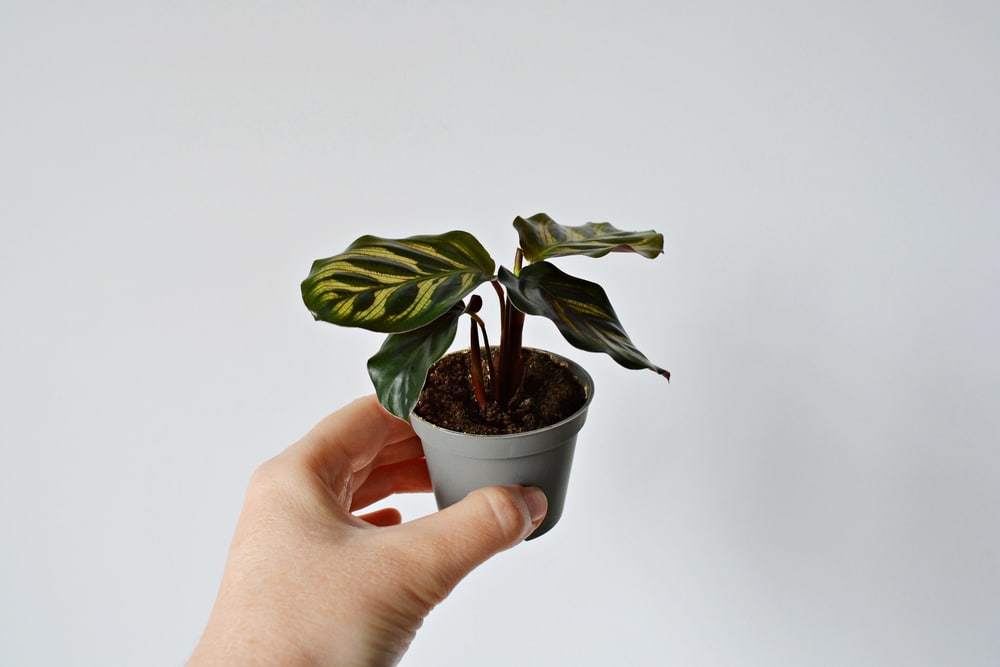
Also called ‘Cathedral Windows’, The Peacock plant is a beautiful work of contrast, with bright and dark green mixed with red and purple for the leaves. The colors contrast in a nice, ribbed striping pattern that really catches the eye, and those brilliant leaves can get to be 10 to 12 inches long. Said leaves like to stand up, however, keeping the plant quite manageable in low-space scenarios and it tops out at about 2 feet tall.
For the soil, mix up 2 parts peat along with 1 part perlite (or coarse sand) and you’ve got a great little home for your Peacock plant. This plant likes bright, indirect sunlight, but you’ll also need a humidifier or humidity tray, as it prefers a bit of a tropical atmosphere to thrive in. During the warmer months, you’ll water it about once a week, just check the top 2 inches of soil to make sure that it is dry first. In the winter, watering will be more infrequent, but you’ll need to check the soil to find the perfect schedule for your plant in your location.
17. Moon Cactus – Gymnocalycium mihanovichii
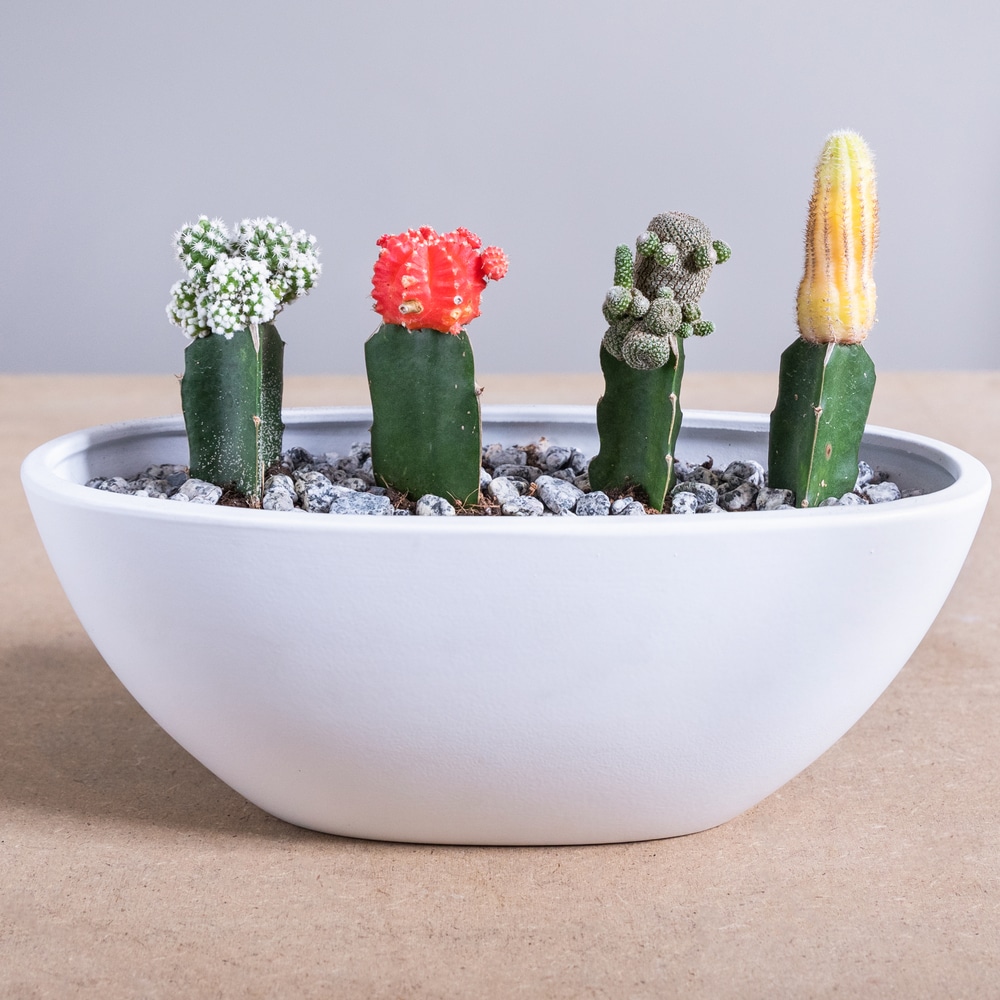
Our final entry is a neat little ‘Franekenplant’ known as the ‘Moon Cactus’. The reason we’re calling it a ‘Frankenplant’ is that these lovely Cactii are the product of a grafting procedure, that adds a top to the Cactus which lacks its own Chlorophyll. This results in a colorful ‘hat’ of red, orange, yellow, purple, and other colors that will definitely be a conversation piece and a beloved addition to your home nature menagerie.
Cactus potting soil with a small amount of perlite or sand added and a porous clay pot for improved drainage will house your Moon Cactus quite nicely. Bright, indirect sunlight is the best for this plant and the watering frequency is mild, but takes a little getting used to. Water it thoroughly after the soil has been completely dry for a week. This will generally come to once every 2 weeks, but check your plant’s soil to find the perfect schedule and to avoid overwatering!
Conclusion
We hope that you’ve enjoyed our trek into the world of mini green marvels. As you can see, there’s a little something for everyone, so if space is a concern, then worry no longer! Just be sure to follow our care steps to a ‘T and before you know it, your home is going to have just the right amount of Nature inside to make that perfect atmosphere that you’ve been craving.
We hope you enjoy your new plants and we’ll see you again soon!
